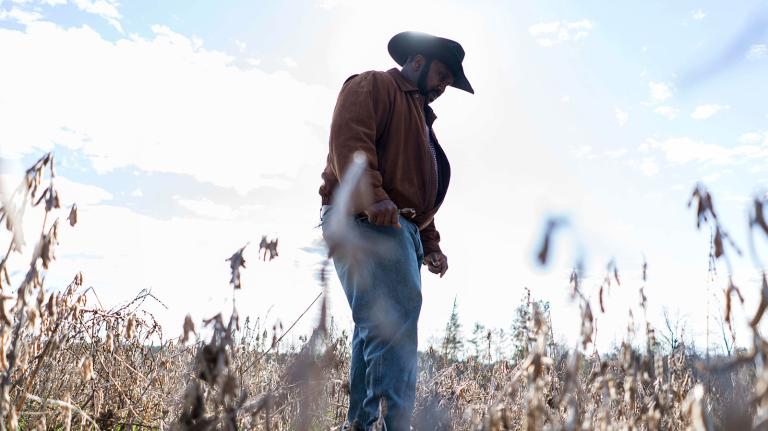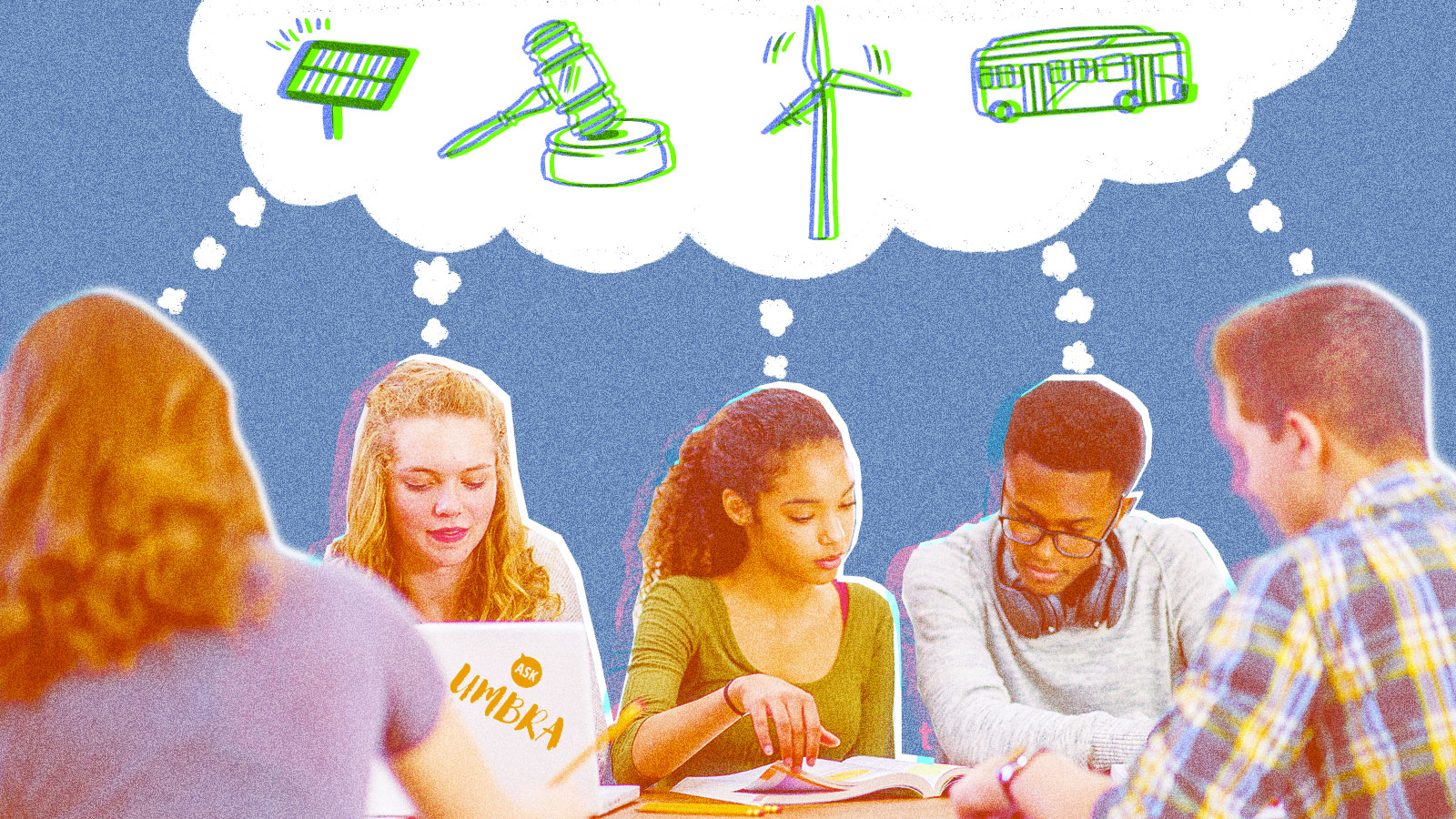Q. Dear Umbra,
What types of programs, initiatives, etc. can help high school students prepare for employment within the green economy?
— Leaping Onto the Sustainability Train
A. Dear LOST,
If this question came to me as recently as a year ago, I might assume it was sent in by an anxious parent trying to suss out how their kid will adapt to a rapidly warming future. I mean, high-school me certainly had some … less important things on her mind.
But times have changed, and in 2019, high-schoolers are kicking most adults’ rent-paying, voting (or not) asses when it comes to adequate concern about the climate crisis. That makes sense, since by the time we’re supposed to have redirected the entire global economy onto a more carbon-efficient route, most high school juniors won’t yet be in the market for a “30 And Flirty” birthday tiara.
So, this advice goes out to all the climate-conscious teens out there. And, at least career-wise, I have some good news: There’s never been a better market for a climate-related job. I mean, someone’s gotta design disaster-resilient buildings, get wind turbines up and running, and litigate all those new climate change lawsuits. How’s that for a silver lining? Unfortunately, depending on where you live, job training opportunities may or may not reflect that — more on that later.
Virtually all of the frontrunning Democratic presidential candidates support the job-creating, climate-crisis-fighting concept behind the Green New Deal. If that abstract framework gets shaped into some viable legislation, we’ll be swimming in green jobs.
Although the Green New Deal resolution isn’t yet a fully formed plan, that doesn’t make it some far-fetched socialist fantasy. Major metro areas like New York are taking on projects that push economic, social, and environmental change simultaneously. And the green job boom the Green New Deal could generate already seems to be in motion: According to the U.S. Bureau of Labor Statistics, the two fastest growing jobs between 2016 and 2026 by a long shot will be solar installers and wind turbine technicians. Plus, both jobs pay well over the median U.S. salary — and that’s before activists rise up and murder all the billionaires in their quest for more equal wealth distribution! I’m kidding — one-percenter assassin is not a green job.
Of course, the emerging green economy includes more than just the clean energy sector. Most experts agree the entire global economy has to transform if we are to make headway on averting the worst consequences of climate change, so few job sectors won’t become green, at least in theory. Kristen Poppleton, Director of Programs for the educational organization Climate Generation, defines green jobs as any that “produce goods or provide services that benefit the environment, conserve natural resources, or make production more environmentally friendly.” Even more broadly, she says, any job where people can “think about how their job is doing something to help the climate crisis” is part of the green economy. So … options!
But one sector to watch in particular is electricity production — a hugely significant source of emissions in the United States, only recently outpaced by transportation as the most polluting sector of the economy. And there are some pretty cool clean energy programs out there designed to help high school students hit the ground running come graduation day.
A lot of those opportunities come down to where you live. Take Tenino, for example. It’s a small town in Western Washington totally revamping its power grid from coal to smart solar energy. City leaders hope that transition will double as a training ground for students from kindergarten all the way through college — as well as provide a job alternative for workers from a local coal plant that’s scheduled to close in 2025. At Bruni High School, an 80-person school in West Texas, students can get certified as wind technicians or earn credits toward an associate’s degree in wind energy technology before a single mortarboard is tossed.
Unfortunately, not all cities recognize the importance of training young people in the green job sector. Nationwide, the opportunities to learn are pretty fractured, says Frank Niepold, a climate education coordinator at the National Oceanic and Atmospheric Administration. “You could get into the next state and [the same opportunities] could all be there, or there could just be tumbleweeds.”
That’s partly because education is mostly funded and planned at the state level, meaning that school programs of all sorts — from climate science classes to art requirements and everything in between — can differ by location. And, in general, states that tend to be more progressive on climate are wealthier and devote more resources to educating their students about it. Complicating matters, the states that educate students about climate change may not be the ones with the most green job opportunities in the not-so-distant future. In Idaho, for example, thriving wind energy contrasts with a recent battle to remove climate science from state education standards.
The reality is, no matter how bullish the Bureau of Labor Statistics is on wind turbine technicians, we’re still in the very nascent stages of a renewable energy boom. Investing a lot in training for jobs that are just predicted to exist can seem pretty risky: “You don’t want to build a workforce before you can hire them,” Niepold says.
But all is not lost, even if you happen to live in a place where there are tumbleweeds instead of green job training programs. Some high schools let students concurrently enroll in local community colleges. Many of those offer classes or entire programs in clean energy and related fields. (As with any of these suggestions: If you’re not sure what your school offers, talk to your school counselor to see what options are available to you.)
And even if you want to stick to your high school’s offerings, you can gain not-so-green skills that will still be valuable in a green economy. If you want to work on electric cars one day, you’ll learn a lot of useful skills through a high school auto-mechanics class (after all, we’re reinventing the engine, not the wheel). Taking a welding class could put you ahead of the game for a wind turbine manufacturing job. Depending on your school, you might have technical education programs in natural resource management, architecture, or infrastructure planning — any of which could be immensely useful in your search for a green job. Heck, even working in a school garden could give you a future edge!
And remember, you certainly don’t have to be dangling from a wind turbine for your career to be climate-forward. Receptionist at a solar technology company? That’s a green job! Sustainable landscape architect? That’s a green job! High school counselor working your butt off to connect students to green jobs? That’s a super-meta green job! If you want work that will help the climate, the best way to prepare for it is simply by pursuing what you love to do. (Unless your passion is pouring oil on pelicans, in which case you might be out of luck.)
And you’re right that it’s not too early to start considering your career. As scary as it sounds, educators say that middle school is the ideal time to start thinking about what job you might want, so you can take the classes that’ll best prepare you for it. But don’t freak out if you weren’t floating around the womb pondering your place in the green economy. Solar installers are often trained on the job, which you could do in high school during summer break. Anyone who went to college will tell you that that’s also as good a time as any to start freaking out about your career path. You can even grow up to become a Ph.D. climate scientist without acing AP Calc in high school (mad props to the nerds who did, though).
And if you’re still frustrated with your school’s lack of education and training, you could always try some good old-fashioned direct action to demand it. High school students in Portland recently did just that — and their protest helped push their school district to make good on its promise to improve climate education by hiring a full-time climate justice coordinator. (That’s a green job!) Kids in climate marches across the country have pushed for more comprehensive climate education— not just on the crisis itself, but on how to do something about it.
So maybe address your school board about how you wish you and your classmates were better prepared for jobs in growing, lucrative fields like solar and wind. (Make sure to mention the growing, lucrative part — grown-ups and parents love that). If you’re not ready to seize the local government, talk to your shop teacher about inviting a guest speaker who knows a thing or two about electrical engines, or to your English teacher about having an environmental lawyer speak to the class.
I heartily empathize with the fact that being a teen right now means that you have to worry about climate change more than anyone older than you. And envisioning yourself as part of the solution can be a powerful way to understand that you have agency when it comes to the climate crisis, even if you can’t get your family to go vegan and ban plastic and vote.
But don’t let climate anxieties get in the way of experiencing more typical teenage realities, like thinking about your future job in terms of what might make you super excited to get up every morning (other than gas station Red Bull). In other words, don’t let your desire to single-handedly save the world dictate your whole life. After all, you can’t do it alone. And your best contribution to the climate effort is the one you can commit to wholeheartedly. Otherwise, you might just burn out before the planet does.
Maturely,
Umbra




